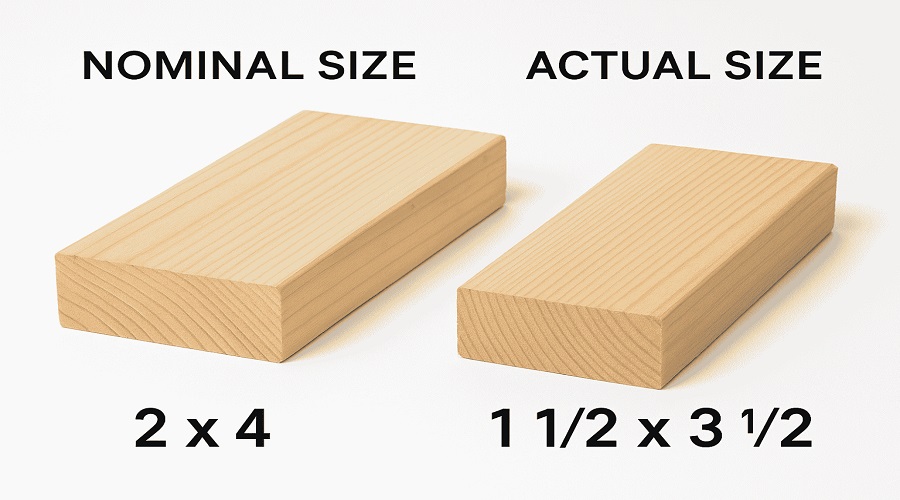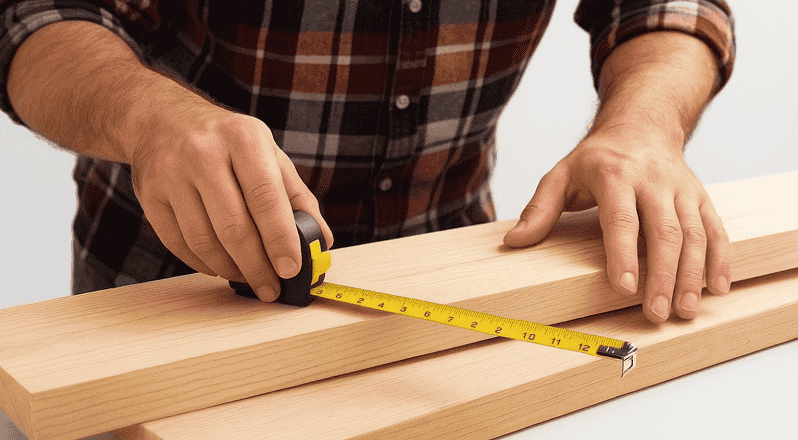If you find the measurements a bit confusing while purchasing wood, always keep in mind that you are not the only one. Wood measurements can be confusing. There are different kinds of wood boards that have different uses. And the measurements can also differ from one kind to another.
What does a label on lumber saying 2x4x8 mean? What is the unit of measurement? Is the label actually telling you the real measurements? Just like that, many questions arise. And if you can understand the basics, the answers should be super easy for you.
In this article, we will discuss the general meaning of the label of measurements in a piece of lumber, the difference between nominal and actual size, size differences for different kinds of lumber, and how you can calculate a log in CFT. Keep reading to learn the basics of wood measurements in detail.
Wood Measurement Calculator in CFT

How It Works
- Input Units: The calculator now accepts thickness, width, and length in centimeters, as indicated by the updated <select> options.
- Volume Calculation: It first computes the volume in cubic feet (cft).
- Amount Calculation: The cost is calculated based on the price per cubic foot in USD.
Usage Tips
- Enter your wood dimensions in inches (e.g., 20 centimeters thick, 6 centimeters wide, 24 centimeters long).
- Set the quantity if you have multiple pieces.
- Click "Calculate Volume" to see the result in cubic feet (CFT).
- Enter the price per cubic feet and click "Calculate Amount" for the total cost in USD.
This setup keeps your woodworking projects on track with accurate conversions!
What Do the Labels Mean?
Most of the time we see labels on wood boards that say something like 2 x 4 x 8. A wood board with a label of 2 x 4 x 8 may be called a two by four by eight board. But what do these measurements actually say about that particular piece of wood?
Believe me, it is not that difficult to understand if you can grasp the basic idea here!
If you take a closer look at the measurements, we can see 3 different numbers. The three numbers tell us about three specific attributes of the wood. The first number indicates the thickness of the wood in inches, the second number indicates the width of the wood in inches, and the third number indicates the length of the wood in feet.
Always keep in mind which number indicates which attribute of the wood. Another mistake that is commonly made is mixing up the units of measurement. So, don’t forget which number tells you in inches and which in feet!
Softwood vs Hardwood vs Plywood – Wood Measurements
Different types of lumber are prepared differently and used for different purposes. That is why the sizing standards vary from kind to kind. The knowledge about different types of lumber can be really handy as you don’t know what kind of wood board you may need. Let’s briefly discuss the sizing standards –
Softwood
The most common size for softwood is 2×4 which means the board is 2 inches thick and 4 inches wide. This is the nominal size which means the board is actually a little bit smaller than 2×4, it’s 1-½ inches x 3-½ inches.
Apart from the most common size, softwood is available in different thicknesses of 1”, 2”, 4”, 6”, and 8”. And the width of the lumbers is determined based on the thickness of the lumber. These are the nominal size so the actual size is a little smaller in thickness and width. Softwood is normally sold by the piece or by linear feet.

Some common sizes used for softwood:
| Nominal Size | Actual Size |
| 1X3 | 3/4 x 2-½ inches |
| 1X4 | 3/4 x 3-½ inches |
| 1X5 | 3/4 x 4-½ inches |
| 2X3 | 1-½ x 2-½ inches |
| 2X4 | 1-½ x 3-½ inches |
| 2X6 | 1-½ x 5-½ inches |
Hardwood
The sizing standards are a bit more complicated when it comes to hardwood. The difference between the nominal and actual size of the board varies based on the types of hardwood. If the hardwood is surfaced on one side (S1S), the difference between the nominal and actual size is small. And if the hardwood is surfaced on both sides (S2S), the difference between nominal and actual size is bigger.
As an example, a hardwood with a nominal thickness of ½ inches has an actual thickness of ⅜ for S1S and 5/16 for S2S. Unlike softwood, hardwood is commonly sold in board feet and quarters. One board foot is equal to 144 cubic inches and each quarter means ¼ inch of thickness.
So, 1 board foot means hardwood is 1 inch thick, 12 inches wide, and 12 inches long. That makes it 144 cubic inches. And 4/4 quarter means the board is 1 inch thick.

Some common sizes used for hardwood:
| Nominal Thickness | S1S | S2S |
| 1/2 inch | 3/8 inch | 5/16 inch |
| 5/8 inch | 1/2 inch | 7/16 inch |
| 3/4 inch | 5/8 inch | 9/16 inch |
Plywood
You may have seen the most common sizes of plywood which are 4X8 feet and 2X4 feet. The most typical nominal thickness for a plywood board is ½ inch and ¾ inch and the actual thickness is 15/32 and 23/32 inches. Apart from the most typical sizes, plywood can be found with thicknesses of ⅛ inch, ¼ inch, ½ inch, and ¾ inch.
How to Measure a Log in CFT
To measure a tree log in cubic feet (CFT), you need to understand the formal at first. The formula for Cubic Feet of Log= V = π × r2 × h. Here, V means the volume, π is a constant which has an estimated value of 3.1416, r means the radius of the log, and h means the height of the log. But the formula is the easy part, the toughest part is taking the measurements.
Firstly, measure the diameter of the log and divide it in half for finding the radius. Then measure the height of the log. Be really careful when measuring the log. After you have all the values, put them into the formula and you will have your log measurement in CFT.
Converting the Units of Measurements
There will be times when you may need to convert the unit of measurement of wood. And in most cases, the conversion is easier enough so that you can do it all by yourself. Let’s discuss some units that are commonly used.
Inches to Cubic Feet
If the dimensions of the piece of wood are measured in inches and you want to convert it into cubic feet, you have to go through the following steps:
- First multiply the length, width, and height and that will give you a value in cubic inches.
- Then divide the calculated value by 1728, as we know 1728 cubic inches equals one cubic foot.
If you follow these steps, you will get the dimensions in cubic feet.
Meters to Cubic Feet
Let’s say you want to convert the dimensions of a piece of wood from meters to cubic feet. All you have to do is to go through the following steps:
- First multiply the length, width, and height and that will give you a value in cubic meters.
- Then multiply the calculated value by 35.31.
Yards to Cubic Feet
The steps for converting the dimensions of your wood from yards to cubic feet are as follows:
- Firstly, multiply the length, width, and height and that will give you a value in cubic yards.
- Then multiply the calculated value by 27.
What If the Wood Is in Irregular Shape?
If your piece of wood is in irregular shape and you want to measure it, don’t panic. You can measure the piece of wood easily just by measuring the small regular shapes hidden in the big irregular shapes.
As an example, if your piece of wood is L shaped, there must be two rectangles inside the L-shaped wood. You have to measure the rectangles separately and add the values to get your desired measurement of the whole wood.
Alright, let’s break this down like we’re chatting in a workshop over a cup of tea. Wood measurements confuse a lot of people at first, but once you know the “secret code,” it all makes sense.
How do you read wood measurements?
Straight answer: Lumber is usually listed as thickness × width × length.
Example: 2x4x8 means 2 inches thick, 4 inches wide, and 8 feet long.
But here’s the catch—you almost never get the full numbers. That’s because the lumber is cut “rough” at those sizes and then smoothed down, which makes it smaller.
What are 2x4’s, 2x6’s, and 2x8’s classified as?
They’re called dimensional lumber.
That’s just a fancy way of saying wood that’s cut to standard sizes for construction.
How do we measure wood?
Thickness first, width second, length last. Always in inches for the first two, and usually feet for the last one.
Think of it like ordering pizza: size (thickness), slice width, then how long the box is.
Is a 2x10 actually 10 inches?
Nope. A “2x10” actually measures 1.5 inches × 9.25 inches.
The extra gets shaved off when they smooth and dry the wood.
What is the list of wood sizes?
Common ones:
- 2x4
- 2x6
- 2x8
- 2x10
- 2x12
- 4x4
- 6x6
You’ll also see boards like 1x4 or 1x6 for trim and finishing work.
What does a 2x6 actually measure?
1.5 inches × 5.5 inches.
Why is a 2x4 actually 1.5 x 3.5?
Because when it’s first cut, it’s a full 2 inches by 4 inches.
But after drying and planing (smoothing), it shrinks down.
So what you buy in the store is the “actual size.”
How wide is a 6x6?
Not 6 inches.
It’s actually 5.5 inches × 5.5 inches.
What does a 2x12 actually measure?
1.5 inches × 11.25 inches.
What does 4 by 4 mean in wood?
It’s the nickname for a piece of wood that’s supposed to be 4 inches thick and 4 inches wide.
The actual size is 3.5 x 3.5 inches.
What does 1x6x8 mean?
It’s a board that’s 1 inch thick, 6 inches wide, and 8 feet long.
But really, it’ll measure about 0.75 x 5.5 inches.
What is the actual size of 5x5 lumber?
If you find 5x5, the actual is usually around 4.5 x 4.5 inches.
What does 90 70 lumber mean?
That’s metric sizing.
It means the wood is 90 mm by 70 mm.
What are the common abbreviations used for lumber?
- LF = Linear Feet
- BF = Board Feet (a way to measure volume)
- NOM = Nominal (the name size, like 2x4)
- ACT = Actual (the real size, like 1.5x3.5)
Why is a 2x4 not 2x4?
Because of history. Lumber mills used to sell rough-cut wood that was a full 2 inches by 4 inches.
Once they started smoothing it down, the size shrank, but the old names stuck.
It’s kind of like how we still say “dial” a number, even though phones don’t have dials anymore.
👉 So next time you pick up a “2x4,” remember—you’re really holding a 1.5x3.5.
Nominal vs Actual Lumber Sizes in cheat-sheet table
Perfect 👌 Here’s your cheat-sheet table for lumber sizes. This is the kind of thing I wish someone handed me the first time I walked into a lumber yard:
📏 Nominal vs Actual Lumber Sizes
| Nominal Size | Actual Size (inches) |
|---|---|
| 1x2 | 0.75 x 1.5 |
| 1x4 | 0.75 x 3.5 |
| 1x6 | 0.75 x 5.5 |
| 1x8 | 0.75 x 7.25 |
| 1x10 | 0.75 x 9.25 |
| 1x12 | 0.75 x 11.25 |
| 2x2 | 1.5 x 1.5 |
| 2x4 | 1.5 x 3.5 |
| 2x6 | 1.5 x 5.5 |
| 2x8 | 1.5 x 7.25 |
| 2x10 | 1.5 x 9.25 |
| 2x12 | 1.5 x 11.25 |
| 4x4 | 3.5 x 3.5 |
| 6x6 | 5.5 x 5.5 |
👉 Quick tip:
If you ever forget, just remember—most boards are about ½ inch to ¾ inch smaller than their name.
Wrap Up
Don’t let the different size standards of wood fool you. If you can understand the basics of the size measurement of different kinds of wood boards, you should be a master when it comes to understanding wood measurements.
In this article, we have discussed the difference between the nominal and actual size of lumbers, the size standards of different lumber, how to measure a log in cft, and the standard practices. Now it should be easy for you to understand how the wood measurements work next time you buy some wood.
I’ve written this article based on my own experience, my understanding of the subject, thoughtful research, and of course, the feedback from other users. I hope it will help you with your understanding of wood measurements. Good luck!

